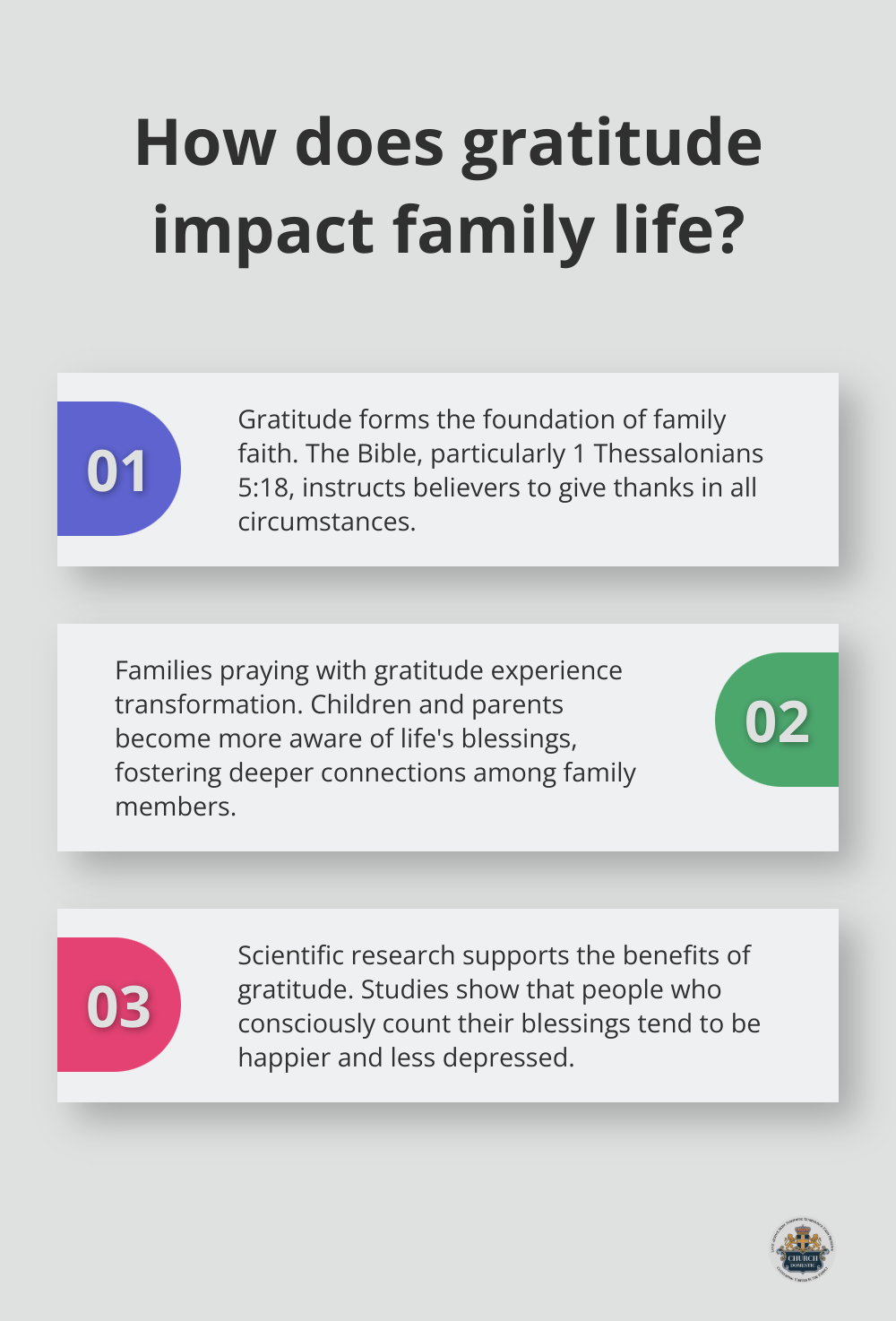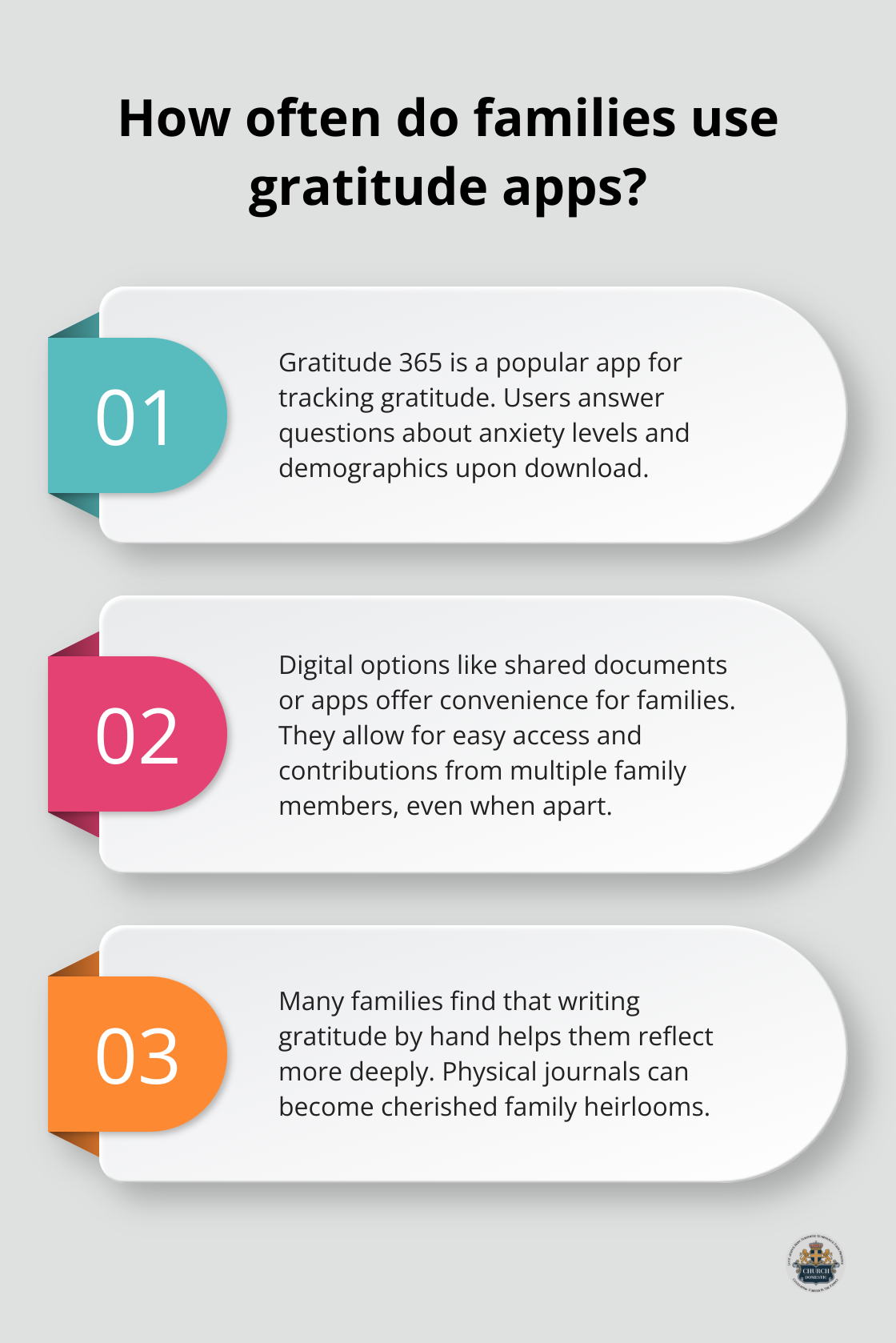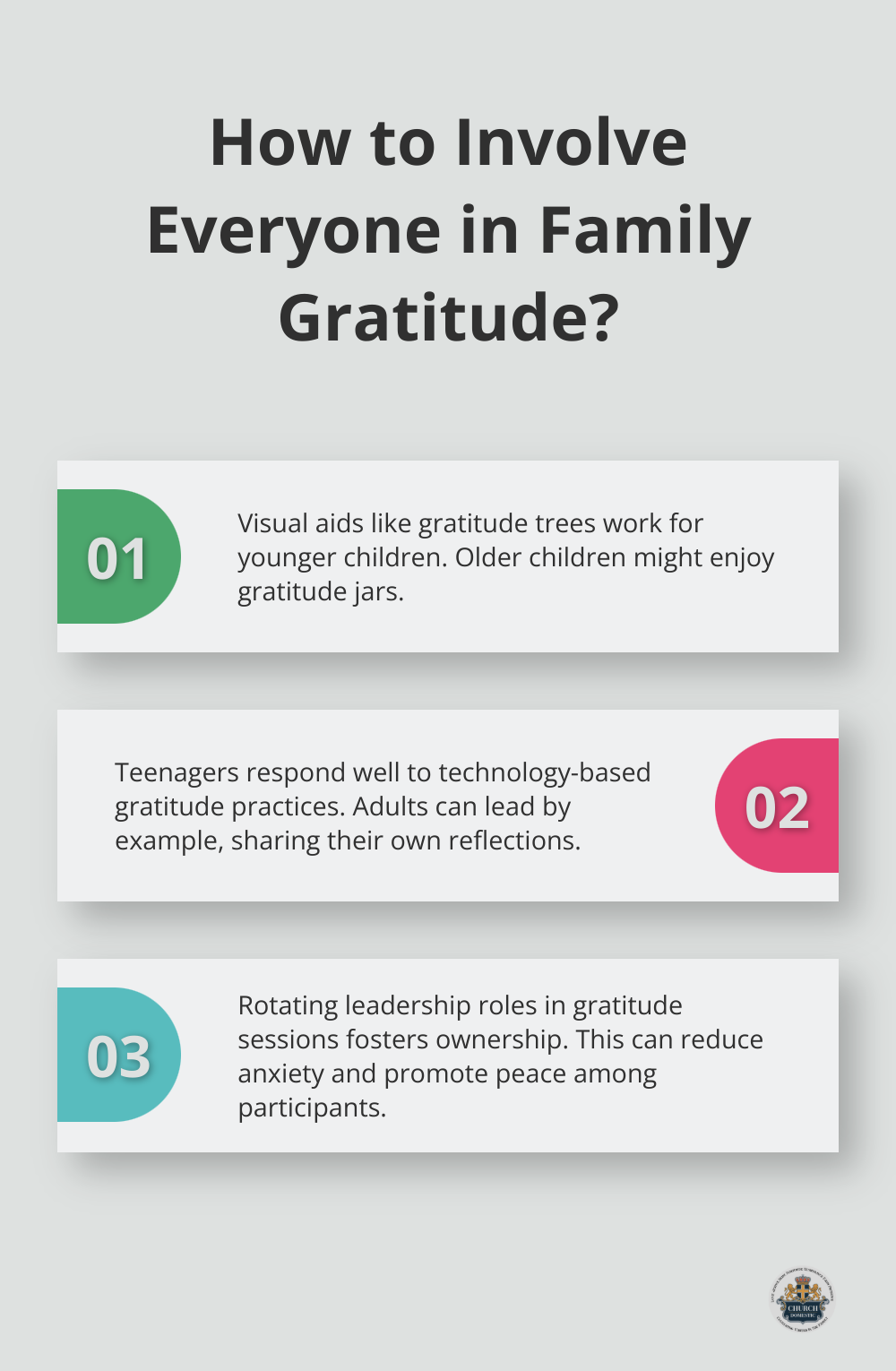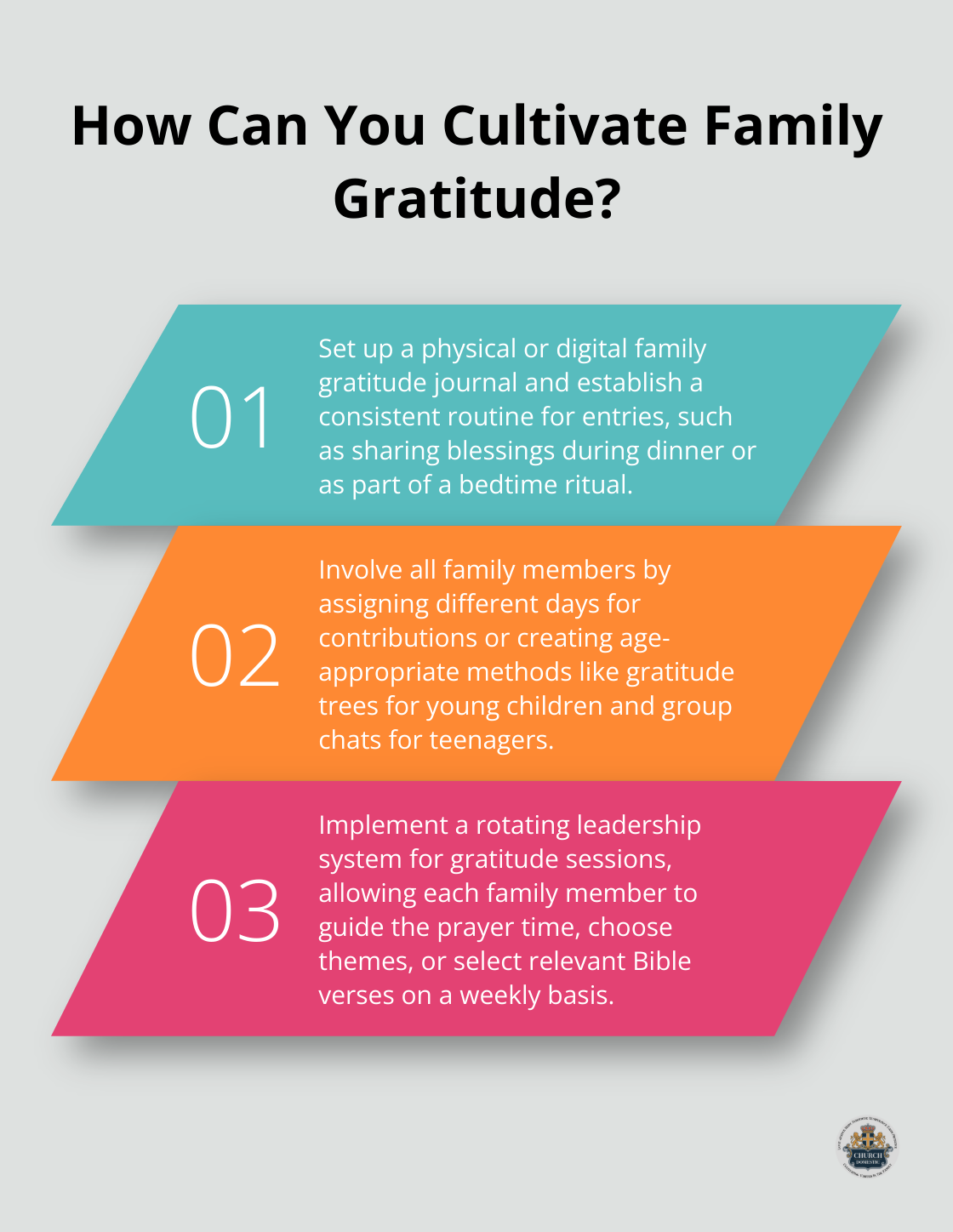At Church Domestic, we believe in the transformative power of gratitude in family life. Prayer journals can be a powerful tool for cultivating thankfulness within your household.
In this post, we’ll guide you through creating a family gratitude prayer log that brings everyone together in appreciation. Get ready to embark on a journey that will strengthen your family’s faith and deepen your connections with each other.
Why Gratitude Matters in Family Prayer
The Biblical Foundation of Thankfulness
Gratitude forms the bedrock of family faith. The Bible brims with calls to thankfulness. 1 Thessalonians 5:18 instructs, “Give thanks in all circumstances; for this is the will of God in Christ Jesus for you.” This verse doesn’t merely suggest; it provides a blueprint for family life.
Gratitude as a Family Bond
When families pray with gratitude, they witness a remarkable transformation. Children begin to notice life’s blessings. Parents become more aware of their good fortune. Even during challenging times, gratitude helps families unite. It acts like a spotlight on God’s goodness, fostering deeper connections among family members.
The Neuroscience of Thankfulness
Scientific research supports biblical teachings on gratitude. Studies reveal that people who consciously count their blessings tend to be happier and less depressed. For families, this translates to fewer grumpy mornings and more joyful interactions.
Practical Ways to Cultivate Gratitude
Try these methods to make gratitude a family habit:
- Initiate meals with a round of thanks (each person shares one positive aspect of their day).
- Create a family gratitude jar (write down blessings and read them together monthly).
- Establish “Thankful Thursday” (dedicate this day to appreciating each other).

These simple practices can shift your family’s entire perspective. Many families report that gratitude prayer logs have revolutionized their home atmosphere. One parent shared, “We used to focus on what we lacked. Now we celebrate what we have.”
Navigating Gratitude Challenges
Let’s face it: some days, thankfulness proves difficult. That’s perfectly normal. Teaching children to find gratitude in tough times equips them with a valuable life skill. It doesn’t mean ignoring problems, but rather finding hope amidst challenges.
Gratitude in family prayer extends beyond saying “thanks” before meals. It represents a lifestyle that, when practiced consistently, can transform your home into a haven of appreciation and joy. As you embark on this journey of thankfulness, you’ll discover that setting up a structured approach can significantly enhance your family’s gratitude practice.
Creating Your Family’s Gratitude Prayer Log
Choose Your Format
The first step involves deciding on the format that suits your family best. A physical journal provides a tangible connection to your prayers and can become a cherished family heirloom. Many families find that writing by hand helps them reflect more deeply.

Digital options like shared documents or apps offer convenience, especially for families with older children. They allow for easy access and contributions from multiple family members, even when apart. Some popular apps include Gratitude 365, which offers features like daily reminders and allows users to answer questions regarding their anxiety levels and demographics upon download.
For those who prefer a hybrid approach, consider a bulletin board or whiteboard in a common area of your home. This allows for quick, visible updates and serves as a constant reminder of your family’s blessings.
Establish a Routine
Consistency plays a key role when starting a new habit. Select a time that fits your family’s schedule. Many find that evening works well, as it allows for reflection on the day’s events. Others prefer mornings to set a positive tone for the day ahead.
Start with a manageable frequency. Daily entries might be ideal, but even weekly reflections can have a significant impact. The important thing is to stick to your chosen schedule.
Try tying your gratitude practice to an existing routine. For example, you could share gratitudes during dinner or as part of a bedtime ritual. This association can help make the practice feel natural and increase the likelihood of it becoming a long-term habit.
Organize Your Entries
Create a simple system for organizing your family’s prayers and reflections. This could include categories like:
- Daily Blessings: Small joys and unexpected pleasures
- Answered Prayers: Specific requests that have been fulfilled
- Growth and challenges: Research indicates that gratitude is associated with an enhanced sense of personal well-being
- Family Milestones: Significant events or achievements to celebrate
Encourage each family member to contribute regularly. You might assign different days to different family members or have everyone contribute daily. The key is to ensure that everyone feels involved and heard in the process.
Make it a habit to revisit past entries periodically. This practice can be incredibly encouraging, especially during challenging times. It serves as a tangible reminder of God’s faithfulness and the many blessings in your lives.
A thoughtfully set up family gratitude prayer log creates a powerful tool for spiritual growth and family bonding. As you consistently engage in this practice, you’ll likely find that gratitude becomes a natural part of your family’s daily life, extending far beyond the pages of your journal. Now, let’s explore how to engage every family member in this gratitude practice, regardless of their age.
How to Involve Everyone in Family Gratitude
Tailoring Gratitude for Different Ages
Visual aids work wonders for younger children. Create a gratitude tree where kids can hang leaves with things they appreciate. Older children might enjoy a gratitude jar, adding notes throughout the week to read during family prayer time.

Teenagers often respond well to technology. Encourage them to use gratitude apps or start a family gratitude group chat. This approach meets them where they are and makes the practice feel relevant to their daily lives.
Adults can lead by example, sharing their own gratitude reflections openly. This vulnerability can inspire deeper family connections and show children that gratitude is a lifelong practice.
Rotating Leadership Roles
Empower each family member to lead gratitude sessions to foster ownership and excitement. Create a weekly rotation where different family members guide the gratitude prayer time. This could involve choosing a theme for the week, selecting a relevant Bible verse, or deciding on a gratitude activity for the family to participate in.
Rotating leadership roles in prayer can significantly reduce anxiety and promote feelings of peace among participants. The rhythmic nature of such practices can be particularly beneficial for family members of all ages.
For younger children, pair them with an older sibling or parent to co-lead. This not only builds confidence but also strengthens sibling bonds. Teenagers might appreciate the opportunity to express their leadership skills in a supportive environment.
Integrating Gratitude into Daily Life
Incorporate gratitude into your family’s daily routines with simple practices. Start with sharing one thing you appreciate at dinner time. This small habit can lead to profound changes in family dynamics.
Create gratitude triggers throughout your home. Place sticky notes with prompts like “What made you smile today?” on mirrors or the fridge. These visual cues serve as reminders to pause and reflect on blessings throughout the day.
Consider implementing a family gratitude challenge. For example, spend a week focusing on gratitude for different aspects of your lives each day (Monday for home, Tuesday for friends, Wednesday for health, and so on). This structured approach can help family members discover new areas of thankfulness they might have overlooked.
Persistence will help gratitude become second nature. It might take time, but with consistent effort, you’ll notice a shift in your family’s outlook. As you start this journey, be patient with yourselves and celebrate the small victories along the way.
Final Thoughts
A family gratitude prayer log will transform your household’s spiritual life. Prayer journals provide a tangible record of God’s faithfulness, strengthening bonds and deepening faith connections. Your family will experience increased joy as you consistently acknowledge blessings, both big and small.

The practice may present initial challenges, but the benefits are worth the effort. You’ll notice subtle shifts in your family’s perspective as complaints decrease and expressions of appreciation increase. Children will become more aware of life’s blessings, while adults find themselves better equipped to handle stress.
We at Church Domestic want to hear about your family’s gratitude journey. Your experiences could inspire others in our community. Share your stories, challenges, and triumphs with us at Church Domestic (our team reads every submission).